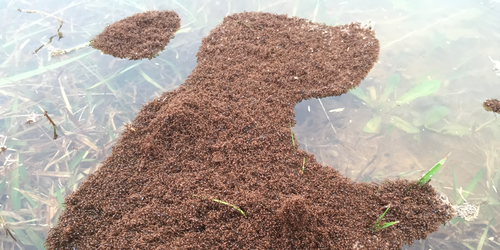Material Properties of Fire-Ant Rafts
In a flood, fire ants can aggregate to form rafts that allow them to float away safely. Researchers interested in biomimetic materials have studied three-dimensional conglomerations of fire ants but not the two-dimensional rafts that form naturally. Now Tzay-Ming Hong of the National Tsing Hua University in Taiwan and his colleagues have investigated two-dimensional rafts floating on water and have found that the rafts’ material properties depend on the speed at which they are stretched [1]. They also found that, thanks to ants filling in holes, a raft can have a zero Poisson’s ratio, meaning it can be stretched lengthwise to some extent without changing its width or height. Normally, only materials with a complicated geometry have this property.
Fire-ant rafts have two key traits: the building blocks (ants) are constantly moving around and cracks heal themselves (because ants fill them in). To find out what material properties result, Hong and his colleagues measured the pulling force as they stretched rafts having two layers—the bottom one bearing the load and the top one serving as a source of gap-filling ants.
Since ants take time to fill cracks, the stretching speed determined the properties. Stretched slowly, at 0.25 millimeters per second (mm/s), rafts were ductile and could double their lengths before rupturing. Stretched at 1.7 mm/s, rafts ruptured after an extension of only about 30% and showed characteristics of a brittle material.
The team also found that placing the ants on a dry, shaking surface prompted them to aggregate and that dead ants in water didn’t form rafts. So the usually assumed clustering mechanism—the so-called Cheerios effect, whereby floating objects congregate naturally—appeared not to provide the full explanation.
–David Ehrenstein
David Ehrenstein is a Senior Editor for Physics Magazine.
References
- C.-H. Chen et al., “Formation and mechanics of fire ant rafts as an active self-healing membrane,” Phys. Rev. E 109, 014607 (2024).




